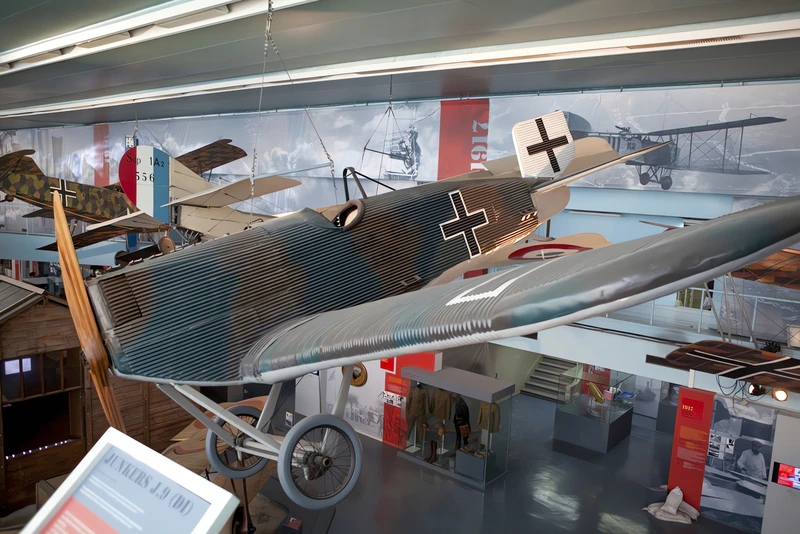
Junkers D.I | |
|---|---|
| Страна | Германия |
| Роля | Боец |
| Първи полет | 17 септември 1917 г. |
| Построен | 41 |
1. Юнкерс Д.И (фабрично обозначение J 9) е монопланен изтребител, произведен в Германия в края на Първата световна война, значим за това, че става първият изцяло метален изтребител, който влиза в експлоатация. Прототипът, частно предприятие на Junkers, наречено J 7, за първи път лети на 17 септември 1917 г., преминавайки през почти половин дузина детайлни промени в дизайна си по време на тестовете си. Когато е демонстриран на Idflieg в началото на следващата година, той се оказва достатъчно впечатляващ, за да доведе до поръчка за три допълнителни самолета за изпитания. Промените, направени от Junkers, са достатъчно значителни, за да може фирмата да преименува следващия пример на J 9, който е доставен на Idflieg вместо трите поръчани J 7s.
Източник: Юнкерс Д.И в Уикипедия
| Junker J9 D1 Walk Around | |
|---|---|
| Фотограф | Unknow |
| Локализация | Не знам |
| Снимки | 22 |
Вижте също:
1. Юнкерс Д.И was a groundbreaking aircraft in the history of aviation, as it was the first all-metal fighter to enter service. It was designed by Hugo Junkers, a German engineer and entrepreneur who had a vision of creating aeroplanes that were more efficient and durable than the conventional wood-and-fabric ones. The Junkers D.I was based on the earlier J 7 prototype, which first flew in September 1917 and underwent several modifications during its tests. The final version, designated J 9 by the company and D.I by the military, had a monoplane wing made of corrugated duralumin, a metal alloy that was light and strong. The fuselage was also made of duralumin, with a tubular steel frame covered by metal panels. The engine was a water-cooled BMW IIIa inline six-cylinder, producing 185 horsepower. The armament consisted of two fixed Spandau machine guns mounted on the nose.
The Junkers D.I was introduced in 1918, near the end of World War I. It was intended to be a naval fighter, as it could withstand harsh conditions and land on rough terrain. However, it did not see much combat action, as it was delivered too late and in too few numbers. Only 41 aircraft were built, and most of them were sent to a naval unit that operated on the Eastern Front after the armistice. The Junkers D.I was not very maneuverable, but it had a high speed and ceiling, and excellent stability and durability. It was also easy to maintain and repair, thanks to its metal construction. The Junkers D.I was a pioneer of the all-metal aircraft design, which would become dominant in the following decades. It influenced the development of later Junkers models, such as the F-13 airliner and the J.I ground-attack aircraft. The Junkers D.I was also one of the first aircraft to use rocket-assisted take-off and in-flight refueling techniques. The Junkers D.I was a remarkable achievement of engineering and innovation, and a milestone in the history of aviation.
Views : 1258


